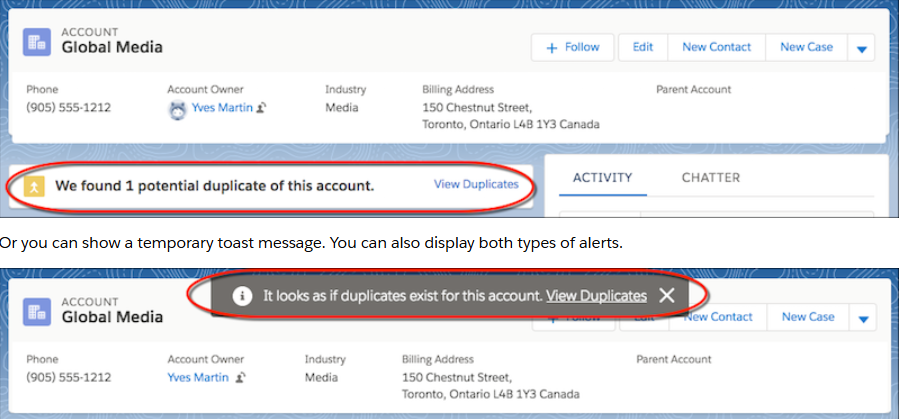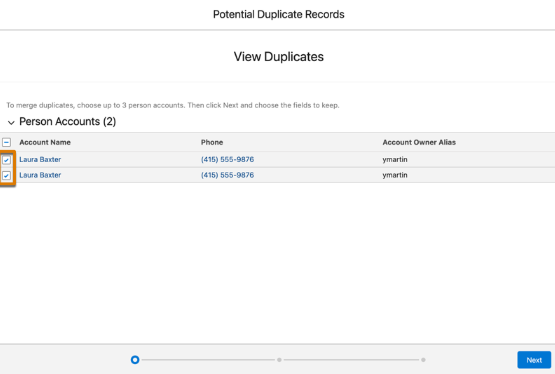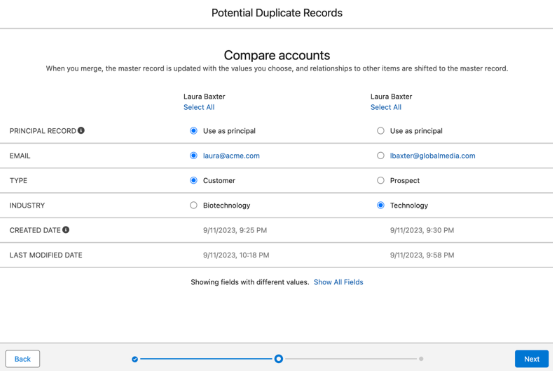Duplicate records are a silent threat in any nonprofit CRM. In the Salesforce Nonprofit Success Pack (NPSP), they can lead to missed communications, inaccurate reports, and fractured donor histories. Fortunately, Salesforce offers native tools and workflows to identify, prevent, and merge duplicate donor records — without breaking your data.
This article outlines how to safely manage duplicates in Salesforce NPSP and how to implement a long-term strategy for maintaining clean, reliable data.
1. Why Duplicates Appear in the First Place
Duplicates often occur when:
- Team members manually enter new donor records without checking if they already exist.
- Data is imported from spreadsheets or forms with inconsistent formatting.
- Slight variations exist in name, address, or email (e.g., “Michael” vs. “Mike”, “Elizabeth” vs. “Eliza”).
- Multiple staff input the same person using different versions of their name or address.
These inconsistencies may seem harmless — but they fragment a donor’s record and lead to confusion, inefficiency, and reporting errors.
2. Automate Detection with Matching & Duplicate Rules
Salesforce helps you catch duplicates before they're saved using two core mechanisms:
- Matching Rules identify potential duplicates by comparing fields like name, email, or address using both exact and fuzzy logic.
As part of the process of creating match key values, matching rule field values are normalized. How a field value is normalized depends on several factors, including the matching method for that field as specified in the matching rule. In addition, some commonly used fields are normalized to optimize duplicate detection.


- Duplicate Rules define how the system responds — whether to allow, block, or alert users when a duplicate is detected.
A duplicate rule defines what happens when a user views a record with duplicates or starts creating a duplicate record. Salesforce provides standard duplicate rules for business and person accounts, contacts, and leads. You can also create duplicate rules.


Set up rules for Contacts, Accounts, and Leads to ensure duplicates are flagged during both manual entry and imports.
3. Configure Record Pages to Surface Alerts
Once rules are active, add the Potential Duplicates component to Lightning record pages (Contacts, Leads, Accounts). This enables:
- Real-time alerts directly on record views
- Visibility into matching records with an option to “View Duplicates”
This keeps users informed without interrupting workflows.

4. Merge Duplicates Effectively
When duplicates are confirmed:
- Select up to three records to merge
- Choose a primary record to retain ownership and relationships
- Review fields and select which values to keep
Always review data carefully before merging, and avoid batch merges without manual checks.


5. Prevent Duplicates During Manual Entry
Enforce Clear Data Entry Standards:
- Use Full Legal Names
One of the most common sources of duplicate entries is inconsistent naming.
To ensure uniformity:
- Always enter the full legal name as provided in official records or donor submissions.
- Avoid using abbreviations, nicknames, or informal variants in the primary name fields.
Examples of inconsistent naming that cause duplicates:
- Katherine vs. Kettie
- Elizabeth vs. Lizzie or Eliza
- Jonathan vs. Jon or Johnny
- Rebecca vs. Becky or Becca
If a donor prefers to be addressed by a nickname, store it in a dedicated field such as "Preferred Name", but keep the legal name consistent in the primary field.
- Maintain Consistent Address Formatting
Salesforce relies on structured data to detect duplicates. Inconsistent address input can prevent proper matching.
Best practices:
- Use a consistent, standardized format across all address fields.
- Avoid abbreviations, rearranged components, or translated formats.
- Use a consistent address format across all records.
- ✅ 245 Main Street, Boston, MA, USA
- ❌ 245 Main St., MA or USA, Boston, Main 245
- ✅ 245 Main Street, Boston, MA, USA
While these may refer to the same person, Salesforce will interpret them as distinct entries. To accommodate personalization:
- Avoid Unnecessary Abbreviations
Standardize the use of names, titles, organizations, and other common fields:
- Refrain from shortening words like “St.” for “Street”, or “Intl.” for “International”.
- Use full forms to improve searchability and duplication checks.
- Train staff to search before creating new records
These practices reduce errors at the source.
- Make Record Checking Mandatory
To further reduce duplicates:
- Always search for an existing record before creating a new one.
- Incorporate this step into team onboarding, training, and data entry protocols.
- Use Salesforce’s built-in duplicate rules and alerts to enforce checks.
6. Monitor with Monthly Data Reviews
Automation isn’t enough — routine oversight is key:
- Run a monthly report of newly created Contacts
- Check for potential duplicates based on similar names, emails, or addresses
- Merge obvious duplicates and document decisions
Assign this task to a data steward or admin to maintain data quality over time.
7. Additional Pitfalls That May Prevent Duplicates from Being Flagged
Despite best efforts, certain scenarios can still cause duplicates to slip through:
1. Non-Matching Custom Fields
If donor data includes custom fields that aren't included in the matching rule (e.g., Alternate Email, Maiden Name, or Spouse Name), duplicates may not be detected even if records clearly refer to the same individual.
Solution: Regularly review and revise matching rules to include high-value custom fields that represent identity signals.
2. Imported Data Skips Matching Rules
Third-party integrations or bulk imports via Data Loader, API, or other tools may bypass duplicate rules unless specifically configured.
Solution: When importing donor data in bulk from another platform (e.g., via spreadsheet or integration), duplicate detection may not trigger automatically, especially if:
- Names, emails, or addresses are inconsistently formatted
- Data includes abbreviations, nicknames, or partial entries
- No prior check is done against existing records
Why it matters: Even with matching rules in place, Salesforce may not recognize duplicates if imported records don’t align exactly with what’s already in the system.
Best practices:
- Apply the same data standards as manual entry — use full legal names, consistent email formats, and standardized addresses
- Review data for potential duplicates before import
- Ensure the import process includes a post-upload duplicate check
Tip: Treat every import like manual entry — clean, verify, and compare the data first. Even bulk uploads should follow your nonprofit’s naming, formatting, and verification protocols.
3. Household vs. Contact Confusion
In NPSP, Households and Contacts are distinct records. Sometimes, a donor is entered as a new Household or as a Contact under a slightly different Household name — causing a perceived difference in identity.
Solution: Train users on proper creation of Households and Contacts. Use automation to standardize naming conventions across both.
4. International Data Inconsistencies
Global addresses, names, and formats vary widely — e.g., John Smith (UK) vs. Smith, John (Germany).
Solution: For international donor records, configure region-specific formatting logic and normalize values wherever possible.
Conclusion
Duplicate records can damage donor trust, distort reporting, and waste valuable staff time. But with Salesforce NPSP’s built-in features — like Matching Rules, Duplicate Rules, and merge functions — plus a commitment to consistent data entry and proactive reviews, your nonprofit can stay in control.
Clean data doesn't happen by accident — it happens by design. Put processes in place now, and your entire organization will benefit from a trustworthy, reliable CRM.
In addition, duplicates severely limit your ability to analyze donor behavior. If the same donor exists in multiple records, it becomes difficult — or impossible — to accurately determine:
- When their first donation was made
- Which donation was the largest or smallest
- What their total giving amount is over time
Unless donor records are properly identified and merged, each of these metrics will appear fragmented, affecting both operational decisions and fundraising strategy.
Clean records = accurate insights.
Your CRM is only as powerful as the data inside it — make sure it reflects the full picture.
Build those processes now, and your data will thank you later.
.jpg)



.png)

.png)



